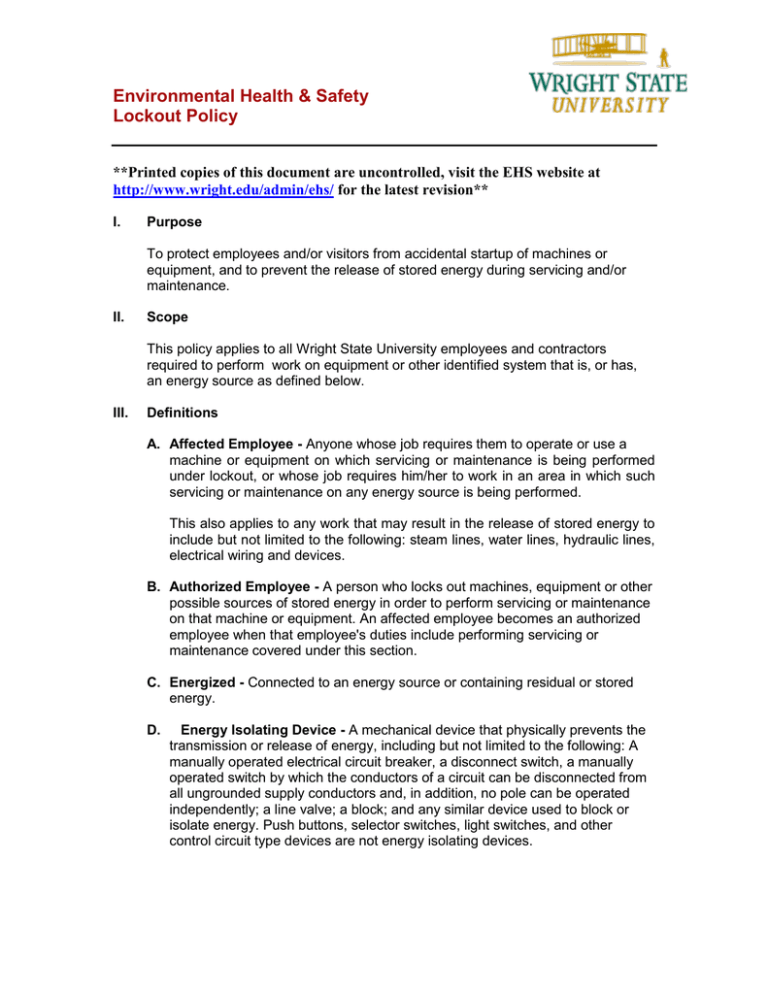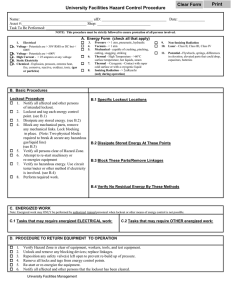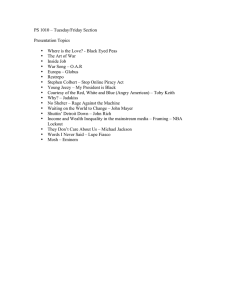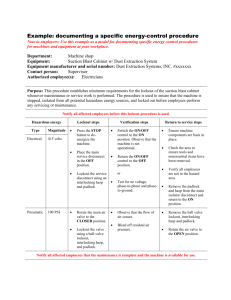Lockout Policy - Wright State University
advertisement

Environmental Health & Safety Lockout Policy **Printed copies of this document are uncontrolled, visit the EHS website at http://www.wright.edu/admin/ehs/ for the latest revision** I. Purpose To protect employees and/or visitors from accidental startup of machines or equipment, and to prevent the release of stored energy during servicing and/or maintenance. II. Scope This policy applies to all Wright State University employees and contractors required to perform work on equipment or other identified system that is, or has, an energy source as defined below. III. Definitions A. Affected Employee - Anyone whose job requires them to operate or use a machine or equipment on which servicing or maintenance is being performed under lockout, or whose job requires him/her to work in an area in which such servicing or maintenance on any energy source is being performed. This also applies to any work that may result in the release of stored energy to include but not limited to the following: steam lines, water lines, hydraulic lines, electrical wiring and devices. B. Authorized Employee - A person who locks out machines, equipment or other possible sources of stored energy in order to perform servicing or maintenance on that machine or equipment. An affected employee becomes an authorized employee when that employee's duties include performing servicing or maintenance covered under this section. C. Energized - Connected to an energy source or containing residual or stored energy. D. Energy Isolating Device - A mechanical device that physically prevents the transmission or release of energy, including but not limited to the following: A manually operated electrical circuit breaker, a disconnect switch, a manually operated switch by which the conductors of a circuit can be disconnected from all ungrounded supply conductors and, in addition, no pole can be operated independently; a line valve; a block; and any similar device used to block or isolate energy. Push buttons, selector switches, light switches, and other control circuit type devices are not energy isolating devices. Environmental Health & Safety Lockout Policy E. Energy Source - Any source of electrical, mechanical, hydraulic, pneumatic, chemical, thermal, electromagnetic, radioactive, kinetic (moving), potential (gravity), or other energy. F. Lockout - The placement of a lockout device and employee identification on an energy isolating device, in accordance with an established procedure, ensuring the energy isolating device and equipment being controlled cannot be operated until the lockout device is removed. G. Lockout Device - A device that utilizes a positive means such as a lock, either key or combination type, to hold an energy isolating device in the safe position and prevent the energizing of a machine or equipment. Included are blank flanges and bolted slip blinds. IV. H. Qualified Person - An employee who has training in avoiding the electrical hazards of working on or near exposed energized circuits. I. Servicing and/or maintenance - Workplace activities such as constructing, installing, setting up, adjusting, inspecting, modifying, and maintaining and/or servicing machines or equipment. These activities include lubrication, cleaning or unjamming of machines or equipment and making adjustments or tool changes, where the employee may be exposed to the unexpected energization or startup of the equipment or release of hazardous energy. Responsibilities A. Environmental Health and Safety 1. Development and maintenance of the university lockout policy and updating as required. 2. Provide training to affected and authorized employees and/or their supervisors and maintaining records of training. 3. Audit training records, lockout procedure reviews, and related documents. This may include auditing lockout procedures to ensure compliance with this policy. 4. Assist departments upon request with the development of lockout procedures for equipment or machines within their department. B. Department Heads 1. Ensure a system within their department is in place to comply with the university lockout policy. 2. Designate and communicate the responsibilities listed in paragraph C) of this section to the managers or supervisors of the department in such a manner as to promote the compliance with this policy. Environmental Health & Safety Lockout Policy C. Managers and/or Supervisors 1. Develop and maintain written procedures for the lockout of each piece of equipment or machine under their control. 2. Ensure authorized employees are issued WSU personal lockout device identification cards for each of their lockout devices. 3. Identify employees that require lockout training and ensure they receive required training. 4. Ensure authorized employees follow safe lockout procedures. 5. Conduct periodic reviews of lockout procedures to ensure compliance with this policy. 6. Ensure personnel have access to area lockout kits containing hasps, valve covers, breaker locks, plug lockout, or other similar devices. 7. Inform contracted service companies of the university’s lockout procedures. D. Authorized/Affected Employees 1. Compliance with this policy and established lockout procedures. 2. Attend all required training. 3. Notify their supervisor of any problems with established procedures. E. Contractors 1. Compliance with their established lockout procedures, as outlined in 29 CFR 1910.147, when working on Wright State premises. 2. Inform the university project manager of their lockout procedures. V. Procedures A. Written Procedures for Lockout Departments must ensure written procedures for the lockout of each piece of equipment or machine under their control. Exceptions to written procedures for a particular machine or piece of equipment must be approved by both the department manager or supervisor and the Department of Environmental Health and Safety. B. General Procedure for Lockout Lockout must be performed in accordance with this procedure whenever specific written procedures are not required. See Section V.A) Written Procedures for Lockout for information on when specific written procedures are required. Environmental Health & Safety Lockout Policy 1. Notify appropriate affected employees that servicing or maintenance is required on a machine or equipment and that the machine or equipment must be shut down and locked out to perform the servicing or maintenance; 2. If the machine or equipment is operating, shut it down by the normal stopping procedure (depress the stop button, open switch, close valve, etc.); 3. De-activate the energy isolating device(s) (such as switches, valves, circuit breakers, etc.) so that the machine or equipment is isolated from the energy source(s); 4. Lockout the energy isolating device(s) with assigned individual lockout device(s); 5. Dissipate or restrain stored or residual energy (such as that in capacitors, springs, elevated machine members, rotating flywheels, hydraulic systems, and air, gas, steam, or water pressure, etc.) by methods such as grounding, repositioning, blocking, bleeding down, etc; 6. Ensure that the equipment is disconnected from the energy source(s) by first checking that no personnel are exposed, then verify the isolation of the equipment by operating the push button or other normal operating control(s) or by testing to make certain the equipment will not operate; Caution: Return operating control(s) to neutral or "off" position after verifying the isolation of the equipment. Note: A qualified person (see Section III, Definitions) must verify that all electrical circuit parts to which employees must be exposed during service or maintenance are de-energized through the use of test equipment. This test must also determine if any energized condition exist due to inadvertently induced voltage or unrelated voltage feedback even in circuits that have been de-energized and presumed safe. If the circuit to be tested is over 600 volts, the test equipment must be checked for proper operation before and immediately after the test. 7. The machine or equipment is now locked out. C. Testing or Positioning of Machines or Equipment The following procedure must be used where lockout devices must be temporarily removed from the energy isolation devices so that the equipment or machine may be energized for testing or positioning. 1. Check the machine or equipment and the immediate area around the machine to ensure that nonessential items have been removed and that the machine or equipment components are operationally intact; 2. Check the work area to ensure that all employees have been safely positioned or removed from the area; 3. Verify that the controls are in neutral; Environmental Health & Safety Lockout Policy 4. Remove the lockout devices and re-energize the machine or equipment for testing or positioning; 5. When testing or positioning is complete, de-energize machine or equipment and reapply control measures. D. Restoring Equipment to Service When the servicing or maintenance is completed and the machine or equipment is ready to return to normal operating condition, the following steps must be taken by the authorized employee who applied the lockout device. If that employee is not available and the lockout device must be removed, follow the procedure outline in Section V.E) Alternate Procedure for Lockout Device Removal. 1. Check the machine or equipment and the immediate area around the machine to ensure that nonessential items have been removed and that the machine or equipment components are operationally intact; 2. Check the work area to ensure that all employees have been safely positioned or removed from the area; 3. Verify that the controls are in neutral; 4. Remove the lockout devices and reenergize the machine or equipment. Note: The removal of some forms of blocking may require re-energization of the machine before safe removal. 5. Notify affected employees that the servicing or maintenance is completed and the machine or equipment is ready for use. E. Alternate Procedure for Lockout Device Removal Lockout devices must be removed only by the authorized employee who applied the devices. However, when that employee is not available and the device must be removed, the following procedure must be used; 1. A supervisor must make every reasonable effort to contact the employee and verify he/she has left the campus and is not within the confines of the equipment in question; 2. Upon verification that the employee is unavailable and not within the confines of the equipment in question, the lockout device may be removed. 3. All reasonable efforts must be made to contact the employee and inform him/her that the lockout device has been removed; 4. The supervisor must ensure that the employee has been informed that his/her lockout device has been removed before he/she resumes work. Environmental Health & Safety Lockout Policy F. Procedure for Group Lockout When servicing and/or maintenance are performed by more than one person, the following procedure must be used. This procedure has been designed to provide an equivalent level of protection as that provided by individual lockout devices. 1. One authorized employee must be designated as responsible for a set number of employees working under the protection of a group lockout device; 2. Each employee in the group must review the lockout procedure to be used; 3. If more than one crew, craft, etc., is involved, one authorized employee must coordinate the lockout to ensure that all control methods are applied and that there is continuity of protection for the group; 4. Each authorized employee must affix a personal lockout device to the group lockout device, group lockbox, or comparable device before beginning work, and must remove it upon completion of their work. G. Plug and Cord Connected Equipment Before any work or maintenance is performed on plug and cord connected equipment, either portable or fixed, employees will unplug the equipment from its power source (This includes blade change out on any power saw) or lockout the power source. If you are unable to maintain control of, or are out of sight of the plug before maintenance is complete, attach a lockout to the plug. H. Procedure for Shift or Personnel Changes This procedure must be used during shift or personnel changes to ensure the continuity of lockout protection, for individual and group lockout. 1. On-coming authorized employees must immediately exchange like lockout devices with the off-going authorized employees; 2. Re-testing to ensure the de-energized state of the equipment; 3. Employees must discuss the status of maintenance or servicing and any notification of start-up or testing to be performed. VI. Training and Recordkeeping All authorized and affected employees and their supervisors must receive initial and annual training. Retraining must also be given for employees whenever there is a change in job assignment, change in machines, equipment, or process that presents a new hazard, or a change in the lockout program. Retraining must also be given whenever periodic inspections identify a deficiency in the procedures. Environmental Health & Safety Lockout Policy Training records will be maintained by EHS and/or departmental managers or supervisors. Records shall include the date(s) of the training program, the instructor(s) of the training program, a copy of the written material presented, and the names of the employee(s) to whom the training was given. VII. References OSHA CFR 1910.147 - The Control of Hazardous Energy (Lockout/Tagout) VIII. Approval Implementation Date: 2-23-2009 Approval: Last Reviewed: Stephen Farrell Director, EHS Last Revision Date: Signature: (Signature on File) _______________________________ Stephen Farrell



